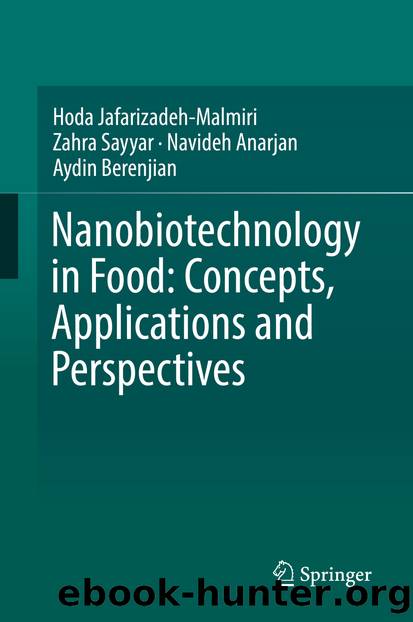Nanobiotechnology in Food: Concepts, Applications and Perspectives by Hoda Jafarizadeh-Malmiri & Zahra Sayyar & Navideh Anarjan & Aydin Berenjian

Author:Hoda Jafarizadeh-Malmiri & Zahra Sayyar & Navideh Anarjan & Aydin Berenjian
Language: eng
Format: epub
ISBN: 9783030058463
Publisher: Springer International Publishing
5.4 Biodegradable Coatings and Films
Biodegradable coatings are thin layers of edible component applied to the fruit’s surface in addition to or as a replacement for natural protective waxy coatings that act as a physical barrier towards carbon dioxide, oxygen and moisture movement for the fruits. Coatings can be formulated from different components such as hydrocolloids (polysaccharides and proteins), lipids (waxes and resins) and synthetic polymers. These edible materials have different barrier properties against gases and physico-chemical and mechanical characteristics. Therefore, most coatings are made of more than one material with the addition of low molecular weight molecules including sorbitol, polyols or glycerol that serve as plasticizers. Biodegradable coatings are applied on fruits and vegetables to improve appearance, delay ripening, reduce water loss and decay, and extend shelf life, but may also change flavor. In fact, semi-permeable coatings can modify the internal atmosphere of fruits by changing the composition or concentration of standard atmosphere gases, like controlled atmosphere storage, with less expense incurred. The atmosphere created by coatings is strongly related to the permeability of the coating and fruit respiration rate and can alter as function of environmental conditions including temperature and humidity (Jafarizadeh Malmiri et al. 2011a, b, 2012a, b). Biodegradable films are the prepared films by natural biopolymers which are wrapped around the fruits and vegetables and create a modified atmosphere within them and delay their ripening process (Berenjian et al. 2015).
The polysaccharides as coating materials for fruits have been used extensively in the past few years. Cellulose and its derivatives, such as methyl cellulose, carboxymethyl cellulose, hydroxypropyl cellulose and Hydroxypropyl methylcellulose, and chitosan as a cationic and antimicrobial polysaccharide, have been widely used in the formulation of edible coatings and films (Berenjian et al. 2015; Jafarizadeh Malmiri et al. 2011a, b).
Incorporation of some antimicrobial agents into the coating and film formulations can lead to an effective antimicrobial activity, promoting the fruit’s microbial stability throughout storage. Benzoates, sorbates, short-chain organic acids (e.g. acetic, lactic, propionic, fumaric and citric acids) and fungicides (e.g. benomyl, thiabendazole, iprodione and captan) have been widely used to prepare antimicrobial coatings and films (Jafarizadeh Malmiri et al. 2012a, b). The typical structure of an antimicrobial edible coating is shown in Fig. 5.2.
Fig. 5.2Structure of an antimicrobial coating (Assa et al. 2015)
Download
This site does not store any files on its server. We only index and link to content provided by other sites. Please contact the content providers to delete copyright contents if any and email us, we'll remove relevant links or contents immediately.
Craft Beer for the Homebrewer by Michael Agnew(18140)
Marijuana Grower's Handbook by Ed Rosenthal(3619)
Barkskins by Annie Proulx(3312)
Project Animal Farm: An Accidental Journey into the Secret World of Farming and the Truth About Our Food by Sonia Faruqi(3177)
The Plant Messiah by Carlos Magdalena(2883)
Red Famine: Stalin's War on Ukraine by Anne Applebaum(2873)
0041152001443424520 .pdf by Unknown(2784)
Organic Mushroom Farming and Mycoremediation by Tradd Cotter(2626)
In the Woods by Tana French(2532)
Beer is proof God loves us by Charles W. Bamforth(2370)
7-14 Days by Noah Waters(2361)
Reservoir 13 by Jon McGregor(2242)
Borders by unknow(2227)
Meathooked by Marta Zaraska(2220)
The Art of Making Gelato by Morgan Morano(2216)
Birds, Beasts and Relatives by Gerald Durrell(2175)
Between Two Fires by Christopher Buehlman(2164)
The 7 Habits of Highly Effective People: Powerful Lessons in Personal Change (25th Anniversary Edition) by Covey Stephen R(2139)
The Lean Farm Guide to Growing Vegetables: More In-Depth Lean Techniques for Efficient Organic Production by Ben Hartman(2096)
